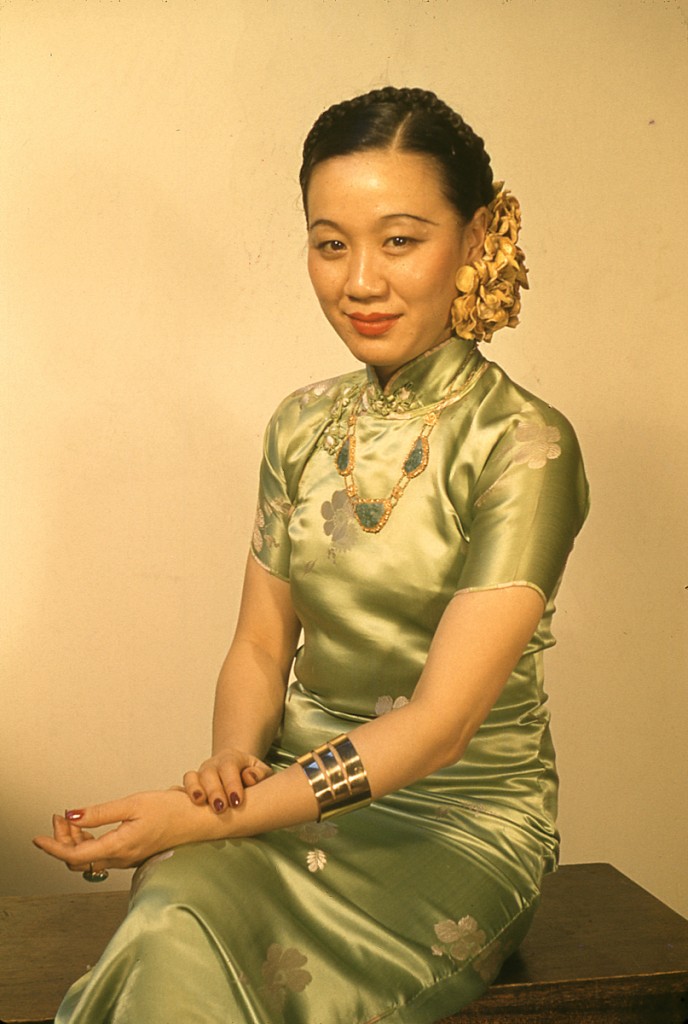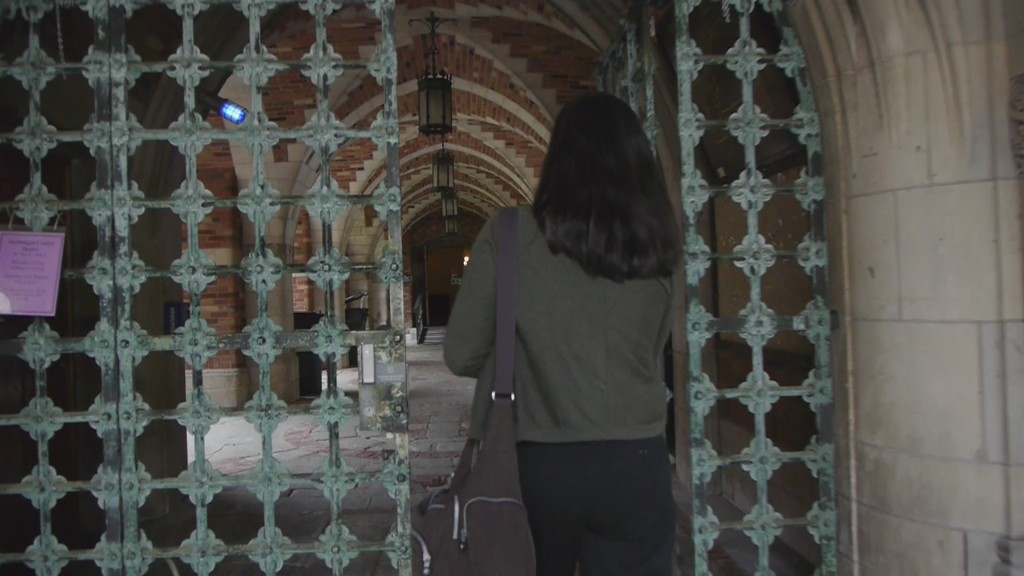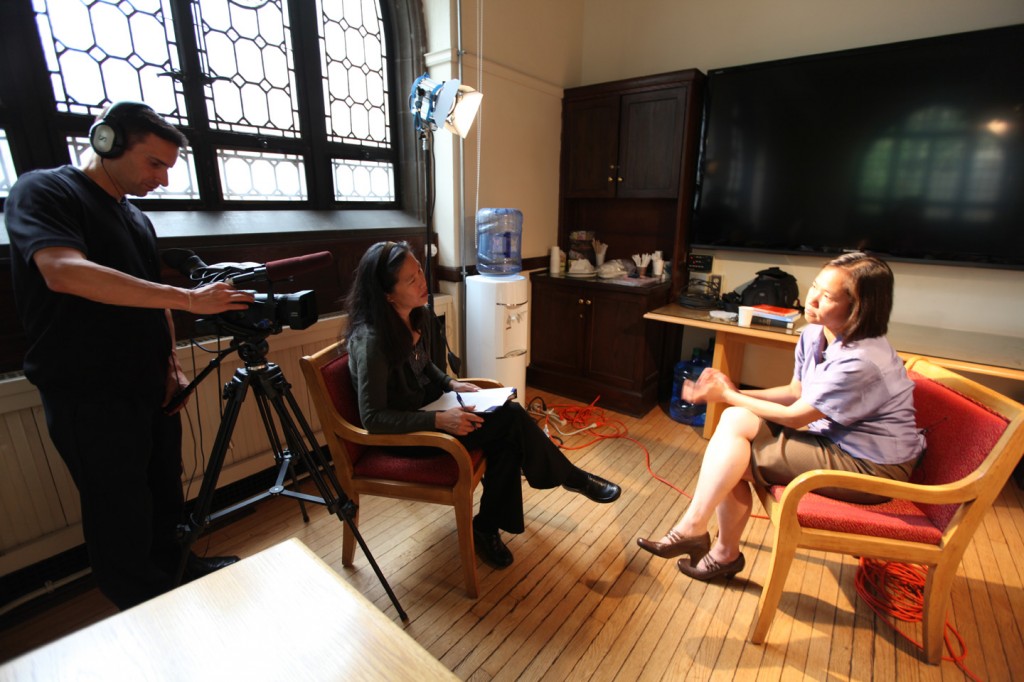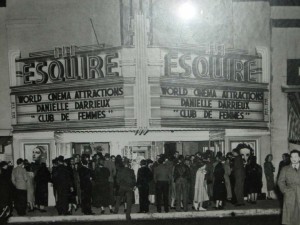Upcoming Screenings:
no event
Follow us on Facebook
HELP BRING FINDING KUKAN TO CLASSROOMS
Sign up for our mailing list.
Category Archives: Li Ling-Ai
September 8, 2012 — Fashion Photos Discovered
Late tonight I am putting off writing a presentation for upcoming October events and browsing the wonderful photos of Li Ling-Ai that Softfilm blogger Durian Dave discovered in the LIFE photo archives. These are all of a United China Relief Fashion show in May 1941 and taken by Alfred Eisenstadt (note KUKAN would premiere the following month in NYC — it must have been a heady time for Li Ling-Ai).

Li LIng-Ai models traditional Chinese robe at May 1941 fashion show for United China Relief.
I love seeing this crowd shot of all the NYC socialites wearing their hats. While viewing these photos, a bell rang in my head and I remembered some of my research at the Columbia Rare Book and Manuscript Library. A fashion show had been held at the Hotel Pierre. Sure enough, I compared a current photo of the penthouse ballroom and the archways are the same. I got chills remembering that I had been to a wedding at that same spot back in the 90’s.
I had no idea that Li Ling-Ai participated in the fashion show when I took those notes at Columbia a couple of years ago.

Li Ling-Ai, with actress K.T. Stevens, James Blaine, Lee Ya Ching, and unidentified Chinese woman
Li LIng-Ai is seen here posing with James Blaine, national chairman of United China Relief and the president of Marine Midland Trust. He was just one of the NYC CEOs that Henry Luce recruited to lead the huge fundraising effort to aid China prior to WWII.
These photos bring this 1941 event to life for me in a whole new way. However, LIFE photographs are notoriously expensive to license. So if I’m going to use them in the documentary, I’m going to have to have a fundraiser myself. Speaking of which… Be on the lookout for our Kickstarter launch in October, and if you’re in Honolulu on October 28, come to our “Night in Old Shanghai” cocktail party benefit where we will pay homage to the efforts of these 1941 fashionista fundraisers.
August 10, 2012 — Li Ling-Ai 75 Years Ago
When I was invited recently to participate in a conference to commemorate the 75th anniversary of the Nanking Massacre this coming December, I realized that the film KUKAN also celebrates a whole string of 75th year anniversaries. Today happens to be the day that Li Ling-Ai (aka Gladys Li) appeared on the front page of the Honolulu Star Bulletin newspaper, lauded for her desire to fly a plane to support China’s resistance to Japanese invasion.
A month before this Amelia Earhart’s plane disappeared. It’s a reminder that in 1937 airplane flight was still relatively new and few women were undertaking the risky hobby.
Flying a plane is just one of the pioneering feats of Li Ling-Ai and what brought her to the attention of the Advertiser reporter Rey Scott who would eventualy become her filmmaking partner on Kukan.
Also noteworthy is that the author of the Star Bulletin article, May Day Lo, was one of the first Asian American female reporters on a major city newspaper.
Have any other 75th anniversaries to share? Feel free to comment.
July 11, 2012 — Cheongsam Dreams
Warning: Use of undefined constant uftp_specialarraysearch - assumed 'uftp_specialarraysearch' (this will throw an Error in a future version of PHP) in /home/nested5/public_html/wp-content/plugins/ultimate-photo-widget-by-eth/gears/source-pinterest.php on line 30
Li Ling-Ai, the Chinese American author who lured me into FINDING KUKAN, was known for always wearing a traditional Chinese dress known as a cheongsam (or qipao in Mandarin).
I didn’t always have an appreciation for the style since I associated it with my elderly grandmother who lived with us when I was a teenager in the 70s. Her old-fashioned Chinese ways and insistence on wearing a Chinese dress everywhere was a cause of angst and embarrassment to me at a time when appearing too ethnic or Asian was just not the cool thing to do.
But my attitude has changed over the years along with the fashions. All the rage in the 20’s and 30’s when Chinese women were expressing newfound freedoms, the cheongsam was banned in mainland China during the Mao era and later considered too old-fashioned by Chinese women who were going for more modern Western looks in the 70s and 80s. According to this excellent article by Babette Radclyffe-Thomas, sexy Chinese movies like IN THE MOOD FOR LOVE have recently inspired a nostalgia for the cheongsam.

One of the exquisite cheongsams fashioned for Maggie Cheung by IN THE MOOD FOR LOVE art director William Chang
Madonna, Nicole Kidman and Kelly Preston have all been caught wearing the style to glamorous effect at red carpet events.
To honor Li LIng-Ai and the revival of the cheongsam (and also divert myself from writing grant applications), I’ve been collecting cheongsam photos on my Pinterest board. Here are some of my favorites.
— No content found.
— Check your ID and board name.
Have a favorite cheongsam of your own? Post in the comments or send me a link to your pin and I’ll put it on my board.
June 28, 2012 — A Visit to Yale and Chinese Exclusion
The recent FINDING KUKAN shoot at Yale University brought out the perpetual student in me. You can’t help but be awed by the vaulted ceilings and Knights of the Round Table atmosphere of the Hall of Graduate Studies where my interview with Yale Professor of American Studies Mary Lui took place.
The building reminds you how much history has come before you and how much you are ignorant of.
Fortunately the halls of learning at Yale are populated by people like Mary who dedicate their lives to gathering knowledge and disseminating it to people like me.
In trying to understand the social climate that prompted Li Ling-Ai and Rey Scott to risk money and life to make KUKAN, Mary Lui reminded me that the behavior of Chinese Americans like Li Ling-Ai was still governed in part by prejudicial immigration laws enacted against the Chinese — the most infamous one being the Chinese Exclusion Act passed in 1882.
Meant to keep cheap labor from entering the US, the exclusion laws ended up doing much more than that. From restricting the formation of Chinese families, to rendering the few Chinese women around at the time exotic creatures with questionable backgrounds the Exclusion Laws had negative repercussions on even the richest and most educated Chinese Americans. It’s no wonder that with so few Chinese Americans around that stereotypes and misconceptions about them would form.
I came back to Hawaii much better prepared to appreciate the historic bill recently passed by Congress to officially apologize for the prejudicial laws that targeted Chinese and other Asians in America for over 80 years.
One of the stereotypes I had about my own ethnic background was that Chinese don’t make waves and passively accept their fate, letting bygones be bygones.
The courageous efforts of people like Congresswoman Judy Chu and organizations like the 1882 Project belie that stereotype and bring a new validation to the history of Asians in America that will hopefully prompt more stories about an era of exclusion that we still don’t know enough about.
Are there ways that exclusion laws have affected your life? Let us hear from you.
February 15, 2012 — A Fashion Interlude
Recently I had the good fortune of meeting one of Ling-Ai’s nieces who had saved many of Ling-Ai’s papers and possessions. I am currently poring through documents and pieces of paper, looking for clues that tell more about the making of KUKAN. It can be a tedious job. So I took an afternoon off to explore some of Ling-Ai’s fashion accessories that had been painstakingly packed away. Ling-Ai had an obvious flair for fashion. And the vintage clothes lover in me went gaga as I opened this eye-catching tres MOD turquoise hat box.
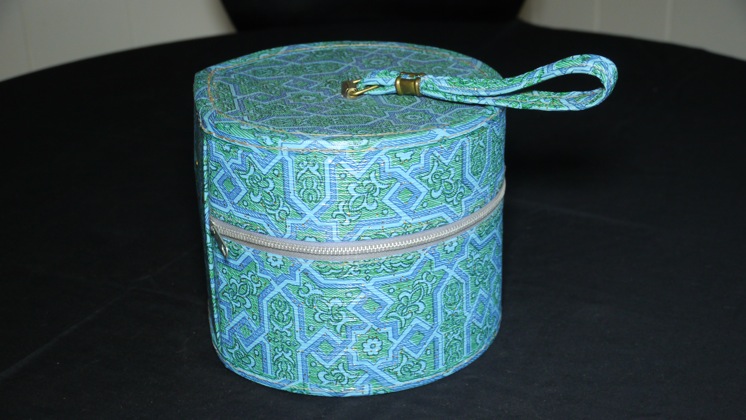
Li Ling-Ai’s Mod Turquoise Hat Box could be a fashion accessory in itself
The contents of the box did not disappoint. I discovered three exquisitely crafted little numbers. A pink brocade small saucer hat with a stunning plume was my favorite.

Plumed pink brocade hat by Nick Savage
I had a lot of fun imagining the type of occasion Ling-Ai chose to wear this hat to.


While photographing this hat, I noticed the amazing craftsmanship that went into it’s construction.

Detail of pink brocade hat.
A signed label was sewn into the inside lining of the hat. Nick Savage appears to be the talented milliner who made it.
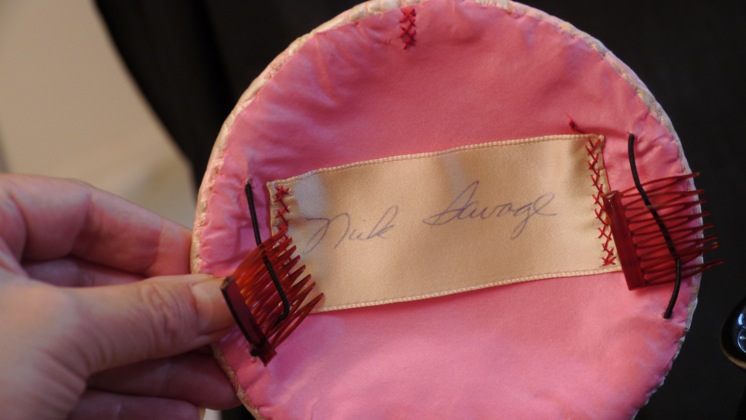
These next two pieces were also made by Nick. And are equally exquisite.

Gold ponytail hat by Nick Savage.Gold-banded camellia hat by Nick Savage

Gold-banded camellia hat by Nick Savage
The little details are marvelous. Check out the separate braided strands that start this gold pony-tail plume.

And the perfect positioning of the brocaded fabric.

The camellia on this inventive piece was a little a squished, but I imagine it was pretty sumptious when Ling-Ai wore it back in the day.

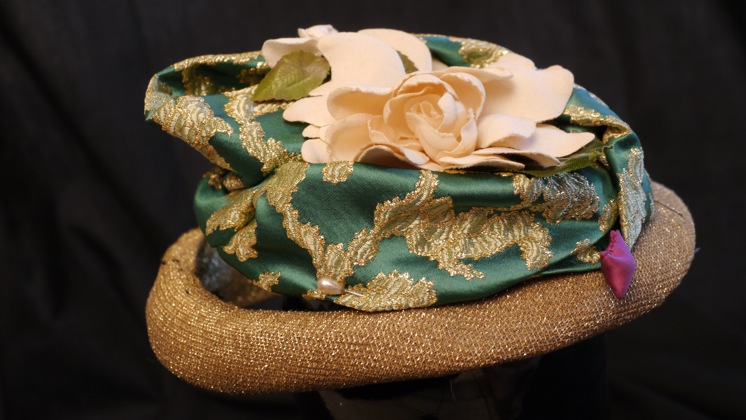

I couldn’t find any information on the internet about the talented Nick Savage. But I did find a little label in the inside of this camellia hat.
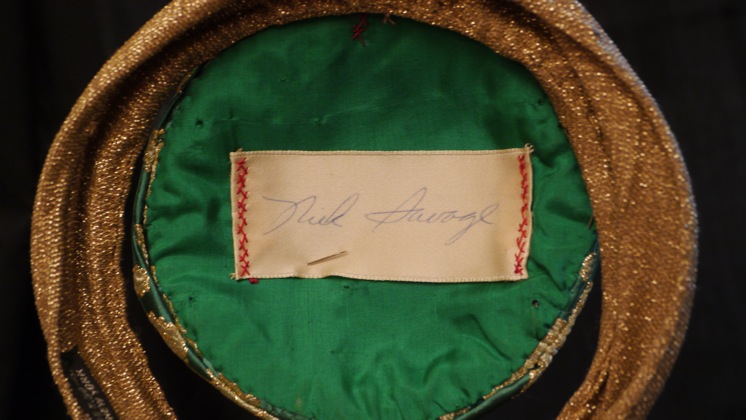
It had a New York City address — 350 East 50th Street — from Google Maps it looks to be a building just off Lexington Ave. If any fashionistas have any more information on him, please let me know. I have Mr. Savage’s millinery gifts, Li Ling-Ai’s fashion sense and her niece’s foresight to thank for a wonderful afternoon spent in a world of gamorous fantasy.

Black velvet rhinestone and pearl studded hat from Li Ling-Ai’s collection.
To top off my post I’ll leave with a few shots of another gorgeous topper in Ling-Ai’s collection (by an unknown maker).


December 1 to 31, 2011 — Producer/Director Robin Lung Featured on Career Changers TV
Although I’m more comfortable being behind the camera than in front of it, I agreed to be profiled on OC 16’s Career Changers TV show in order to get the word out about FINDING KUKAN. Producer Rich Figel and Cameraman/Editor Stan Chang managed to boil my life of job-hopping down to a succinct 4 minutes or so. Even better, the lead in and out of the piece made people really want to see the work-in-progress trailer and learn more about KUKAN. The show airs through December on digital channel 16 or 1016 in Hawaii. The show is rebroadcast Fri 2:30pm, Sat 6:30pm, Sun 12:30am, Mon 9:00am, and Wed 2pm and Thur 8:30pm through December. If you can’t catch it, here is a low resolution version.
You can see the nice lead up to the trailer here. And a fabulous article Rich wrote about “The Mystery of Li Ling-Ai” here.
October 19, 2011 — FINDING KUKAN Excerpts Screen at Evening with Jiang Wen
Two work-in-progress excerpts from FINDING KUKAN (one in its first public showing) will screen as the “opening act” for the University of Hawai‘i sponsored Evening with Jiang Wen, the famous Chinese actor/director who is in Hawai‘i as the featured filmmaker for the 2011 Hawai‘i Intternational Film Festival.
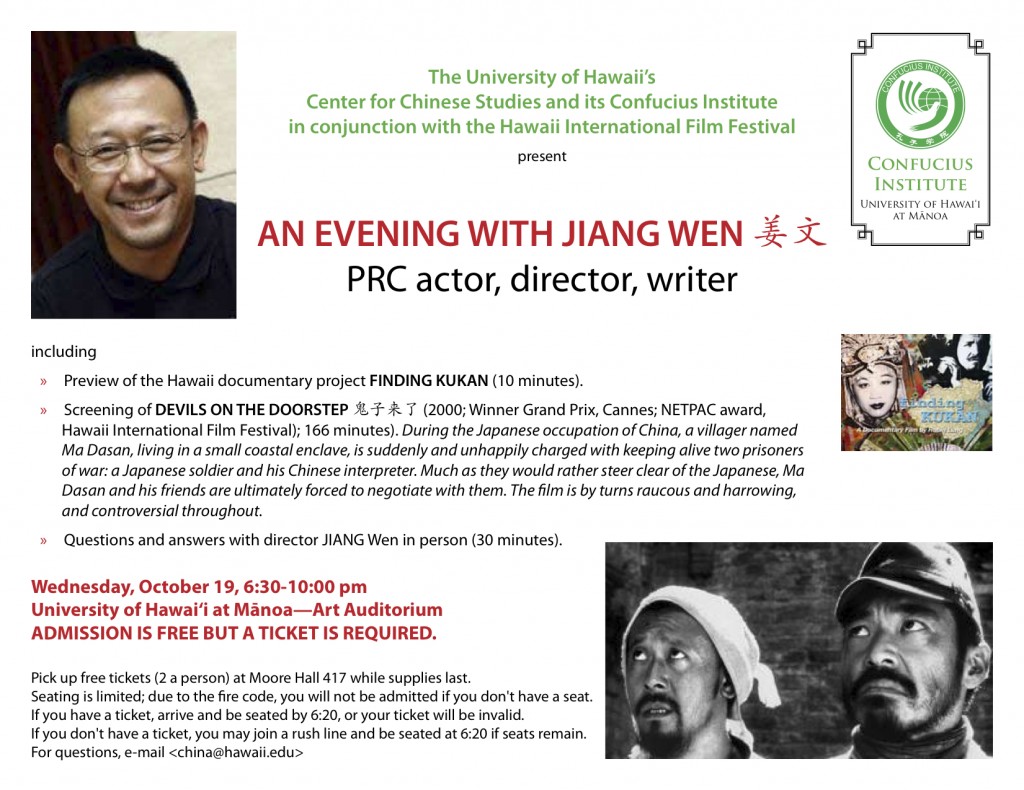
Flyer for FINDING KUKAN Screening at University of Hawai‘i sponsored Evening With Jiang Wen
The evening should be a very special one, and bound to bring great exposure to FINDNG KUKAN. Check it out if you are in the area.or pass the word on to others. Note that the screening is free, but you need a ticket to get in the door. They expect a capacity crowd, so get your tickets early. They are available at UH Moore Hall 417.
July 23, 2011 — A Visit to the New York City Office of the National Archives
When I first started checking to see if Li Ling-Ai could have been the real life inspiration for the fictional detective Lily Wu, I tracked down some of her travels through boat records that are available on Ancestry.com. One of the Ancestry records was a New York Exclusion file that listed the date of her arrival in San Francisco. Going over the notes on the record again, I saw that Li Ling-Ai’s file included an interrogation. Since the interrogation occurred only a year before Li Ling-Ai met Rey Scott and conceived of making the movie KUKAN, I was anxious to read through the interrogation to see if it contained any clues. In July I finally got a chance to visit the NYC office of the National Archives where Li Ling-Ai’s Exclusion file is located.

Robin Lung examines Li Ling-Ai’s Chinese Exclusion File at the NYC office of the National Archives
It was amazingly well-preserved, and I had a lot of mixed emotions while examining it. On the one hand, I was excited to see a photograph of Li Ling-Ai in the file that I had never seen before and letters that were hand-written by her. Handling the documents gave me a very visceral connection to the past and to this woman that I have been pursuing for the last couple of years.

Li Ling-Ai’s Chinese Exclusion File
On the other hand I was appalled that this file existed in the first place. I had to think about the blatant anti-Chinese discrimination that led to The Chinese Exclusion Law — the reason for the creation of the file I was touching. I was astounded that a U.S. citizen like Li Ling-Ai (she was born in Hawai‘i in 1908 when it was already a U.S. Territory) who had a U.S. Passport (documented in the file) would have to spend days at the NYC Immigration Office in order to get a re-entry form that would make it possible for her to come back to her own country after leaving it! And that she would have to sit through an interrogation to prove that she was authentic despite all the other documentation she had made me even more indignant.
As a researcher, I was thankful to be able to access the revealing information in the file and draw both the positive and negative energy from it. So I have to acknowledge the hard work that goes into indexing, storing and retrieving these records. That day at the Archives I witnessed two volunteers who were laboriously going through files and entering data into laptops so that others like me could find information about ancestors and characters from the past. I wish I had gotten their names and taken photos of them if only to pay a small homage to all the others like them who have helped forward my investigation.

Documents in Li Ling-Ai’s Chinese Exclusion File









